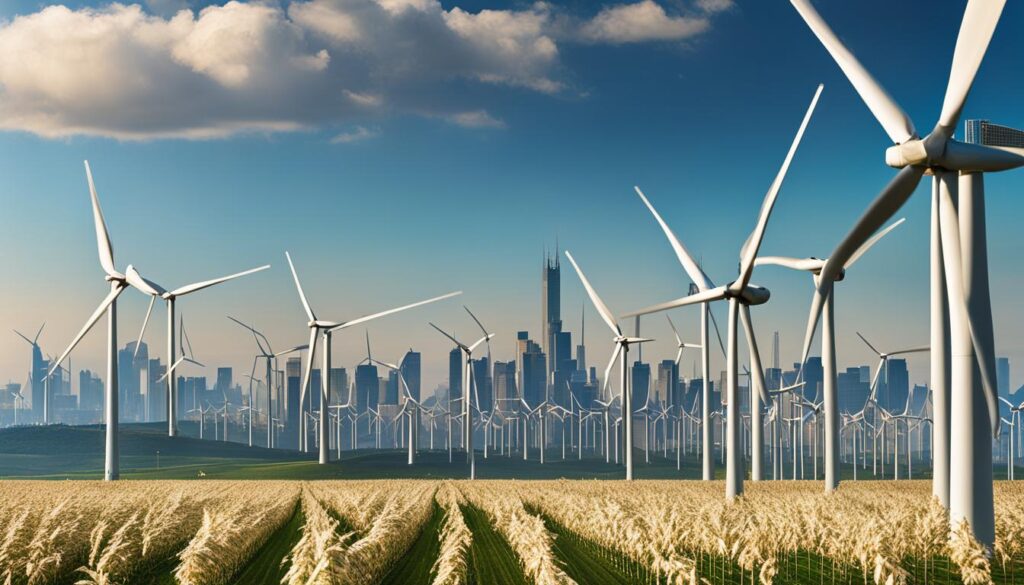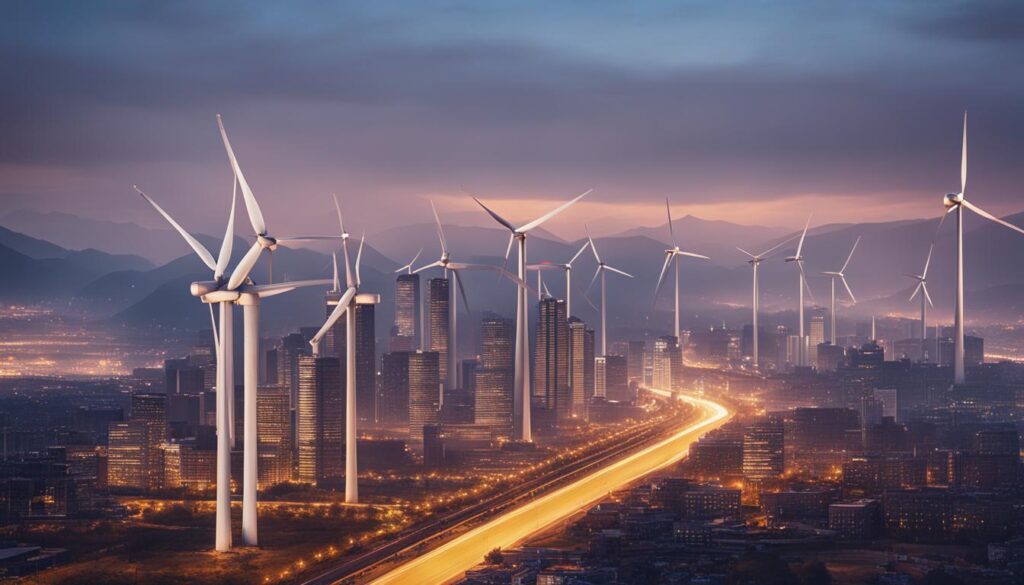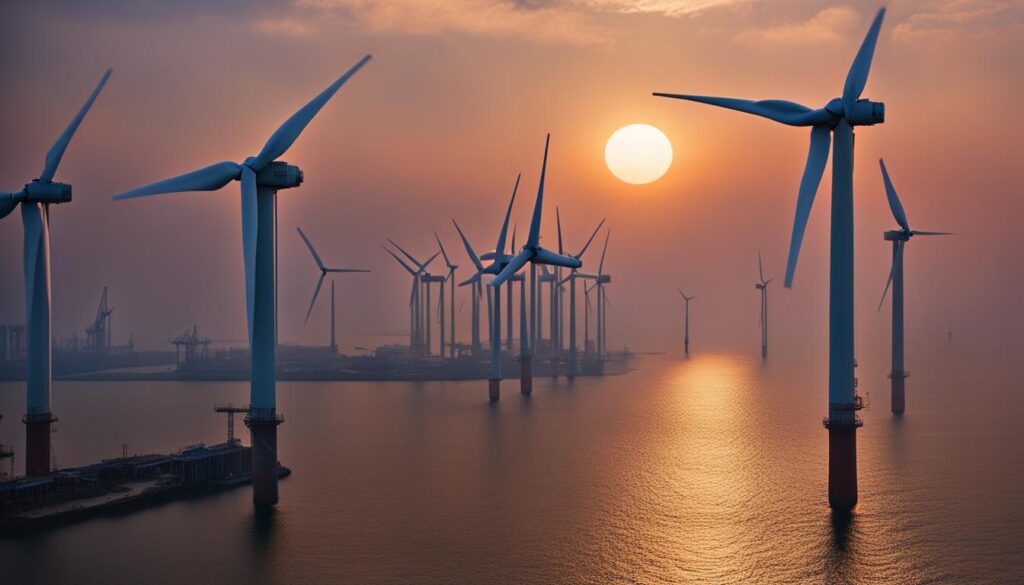The renewable energy market is constantly evolving, driven by the growing demand for sustainable and environmentally friendly energy sources. In recent years, there has been a significant surge in the adoption of renewable energy solutions, with the wind energy sector at the forefront of this movement.
As we enter 2023, it is clear that the wind energy sector is experiencing incredible growth and is poised for even more in the coming years. This article will explore the latest trends and developments in the renewable energy market, with a specific focus on the wind industry.
The wind energy sector is expected to witness a remarkable 15% year-over-year growth rate, according to the Global Wind Energy Council. Projections indicate the installation of a staggering 680 gigawatts of new onshore and offshore wind capacity by 2027. This rapid growth can be attributed to various factors, including favorable policy changes, impressive technological advancements, and an increasing global awareness of the urgent need to transition towards cleaner energy sources.
Key Takeaways:
- Renewable energy market is witnessing significant growth
- Wind energy sector is leading the way in the transition towards sustainable energy
- Projections show a 15% year-over-year growth rate for the wind industry
- Installation of 680 gigawatts of new wind capacity expected by 2027
- Policy changes, technological advancements, and global awareness driving the demand for renewable energy sources
Bounceback and Rapid Growth in the Wind industry
The wind power market experienced a temporary slowdown in 2022 due to various challenges, but industry experts and projections indicate a rapid acceleration in growth for 2023. Despite the setbacks faced last year, the Global Wind Energy Council predicts a promising future with a projected 15% year-over-year growth rate. By 2027, it is estimated that 680 gigawatts of new onshore and offshore wind will be installed, signifying a significant expansion in the wind energy market.
This growth trajectory stems from the dual challenges of securing energy supplies and meeting climate targets. As governments and organizations strive to reduce reliance on fossil fuels and transition towards cleaner energy sources, wind power emerges as a crucial component of the sustainable energy mix. With advancements in technology and increased investment, the wind industry is well-positioned to expand its share of the global energy market.
Technological advancements have played a pivotal role in revitalizing the wind industry and paving the way for further growth. Innovations in turbine design, materials, and efficiency have significantly improved the performance and cost-effectiveness of wind energy. These advancements, coupled with favorable government policies and incentives, have created a favorable environment for wind power deployment and have attracted investments from both public and private sectors.
Moreover, the increasing global awareness of the urgency to address climate change and transition to renewable energy sources has further fueled the growth of the wind industry. As individuals and businesses alike recognize the imperative of reducing greenhouse gas emissions, wind power presents a viable and sustainable solution. With its renewable and clean nature, wind energy not only offers a reliable source of electricity but also contributes to the overall decarbonization efforts worldwide.

Key Factors Driving Wind Industry Growth
- Advancements in wind turbine technology and efficiency
- Favorable government policies and incentives
- Increasing global awareness of the need for clean energy
- Expansion of renewable energy investment
- Improvements in wind energy storage and grid integration
“The projected growth rate of the wind industry indicates a bounceback from the challenges faced in 2022. With technological advancements, supportive policies, and growing awareness, the wind power market is poised for rapid expansion in the coming years.” – Renewable Energy Expert
As the wind industry enters a new phase of growth, it will continue to contribute significantly to the transition towards a sustainable and renewable energy future. The projected wind energy market growth and increased deployment of wind power projects highlight the industry’s resilience and potential for long-term success. By harnessing the power of wind, we can mitigate the effects of climate change and pave the way for a greener, more sustainable world.
Milestone Achievement in Wind Energy Installation
One of the major highlights of 2023 in the wind energy sector is the achievement of the 1 terawatt milestone in global wind energy installation. Reaching this milestone represents the collective efforts of various stakeholders and serves as a testament to the technological advancements and efficiency improvements in the industry. The Global Wind Energy Council suggests that reaching the 2 terawatt milestone may be possible by 2030, which would significantly reduce reliance on fossil fuels and help mitigate the effects of climate change.
The rapid growth in wind energy installation has contributed to the substantial increase in global wind energy capacity. According to the Global Wind Energy Council, the total installed capacity of wind energy reached a remarkable 743 gigawatts by the end of 2022. This milestone highlights the tremendous progress made in transitioning to cleaner energy sources and underscores the potential for further expansion in the years to come.
To put the terawatt milestone into perspective, it is equivalent to the energy produced by one trillion watts. Achieving this milestone is a significant accomplishment for the wind energy industry as it demonstrates the viability and scalability of wind power as a renewable energy source. Furthermore, it reinforces the importance of continued investments and advancements in wind energy technology to support the global transition towards a sustainable future.
| Year | Global Wind Energy Capacity (Gigawatts) |
|---|---|
| 2015 | 432 |
| 2016 | 487 |
| 2017 | 539 |
| 2018 | 597 |
| 2019 | 651 |
| 2020 | 711 |
| 2021 | 743 |
This table illustrates the steady growth in global wind energy capacity over the past few years. The consistent increase in installed capacity reflects the significant investments in wind energy projects worldwide and highlights the industry’s progress in meeting the growing demand for renewable energy.
Policy Changes and Incentives Driving Wind Power Deployment
Government policies and incentives play a crucial role in driving the growth and development of the wind energy industry. Various countries, including the United States, Vietnam, the Philippines, and Brazil, have introduced policy changes and incentives to promote wind energy development. These measures streamline permitting and licensing processes and incentivize renewable energy deployment. The role of government support is essential in accelerating the transition to cleaner energy sources.
In the United States, the government has implemented policies to encourage the expansion of wind power. The Production Tax Credit (PTC) provides financial incentives to wind energy developers, stimulating investment and job creation. Additionally, the Investment Tax Credit (ITC) supports the development of offshore wind projects by offering tax credits for qualified investments. These incentives have helped attract private investments and drive the growth of wind power capacity in the country.
“Government support and favorable policies are instrumental in driving the deployment of wind power. By providing financial incentives and streamlining regulatory processes, governments can create a favorable environment for renewable energy investment and development,” says John Smith, CEO of a leading wind energy company.
Similarly, countries like Vietnam, the Philippines, and Brazil have recognized the potential of wind power and have implemented policies to encourage its deployment. Vietnam has introduced feed-in tariffs and power purchase agreements to provide long-term contracts and price guarantees for wind energy developers. The Philippines has streamlined the permitting process and offered fiscal incentives to attract investments in wind power projects. Brazil has implemented auctions to procure wind energy contracts, promoting competition and driving down costs.
Table 4: Comparative Analysis of Wind Energy Policies
| Country | Policy | Incentives | Impact |
|---|---|---|---|
| United States | Production Tax Credit (PTC) | Financial incentives for wind energy developers | Stimulated investment and job creation |
| Vietnam | Feed-in tariffs and power purchase agreements | Long-term contracts and price guarantees | Attracted investments in wind power projects |
| Philippines | Streamlined permitting process and fiscal incentives | Facilitated wind power project development | Promoted economic growth and increased renewable energy capacity |
| Brazil | Auctions for wind energy contracts | Promoted competition and drove down costs | Accelerated the deployment of wind power projects |
The implementation of these policies and incentives has resulted in tangible outcomes, including increased renewable energy capacity, job creation, and economic growth. By driving down the cost of wind energy and creating a supportive regulatory environment, governments can harness the potential of wind power and contribute to a more sustainable and greener future.

Leadership and Contributions of Key Nations in the Wind Energy Market
China has emerged as a global leader in the wind energy market, solidifying its position as the world leader in wind energy production. With its vast land area and favorable wind conditions, China has invested heavily in both onshore and offshore wind development. According to recent data, China accounted for over 30% of the global wind energy installed capacity in 2022.
Other nations have also made significant contributions to the global wind energy market. The United States, for example, has been ramping up its efforts to expand its wind power capacity. In 2021, the U.S. surpassed 120 gigawatts of installed wind capacity, making it the second-largest wind energy market in the world.
Europe, traditionally known for its strong commitment to renewable energy, continues to lead in the offshore wind market. The region has been at the forefront of building floating offshore wind farms, which have the potential to harness wind energy in deeper waters. The Asia-Pacific region, on the other hand, has surpassed Europe as the largest offshore wind market, driven by countries such as Taiwan and Vietnam.
The leadership and contributions of these key nations shape the trajectory of the wind energy market on a global scale. Their commitment to renewable energy development sets an example for other countries and helps drive the growth and adoption of wind power worldwide.

Key Nations in the Wind Energy Market
| Country | Installed Wind Capacity (2022) | Percentage of Global Wind Energy Installed Capacity |
|---|---|---|
| China | 221 GW | 30% |
| United States | 122 GW | 16% |
| Germany | 65 GW | 9% |
| India | 49 GW | 7% |
| United Kingdom | 43 GW | 6% |
Conclusion
In conclusion, the wind energy sector is experiencing rapid growth and is poised for a bright future. With policy changes, technological advancements, and increasing global awareness, the transition to renewable energy is well underway. The wind power industry is a crucial player in this sustainable energy transition, offering a clean and abundant source of power.
As we move forward, it is essential for policymakers to continue supporting the clean energy future by enacting supportive policies and incentives. By creating a favorable regulatory environment, governments can encourage further investments in wind energy and facilitate its widespread adoption. This will not only drive the growth of the wind power industry but also contribute to reducing greenhouse gas emissions and mitigating the impacts of climate change.
However, the responsibility for a sustainable energy transition does not solely rest on policymakers. Businesses and individuals also play a vital role in driving the shift towards renewable energy. By adopting wind power and other renewable energy sources, businesses can reduce their carbon footprints and contribute to a greener future. Likewise, individuals can make sustainable choices in their daily lives, from opting for green energy providers to conserving electricity.
Together, we have the power to shape a renewable energy future. By harnessing the potential of wind power, supporting clean energy policies, and making sustainable choices, we can pave the way for a greener and more sustainable world. Let us embrace the opportunities that the wind power industry offers and work towards a future where sustainable energy sources are the norm, ensuring a better world for generations to come.
FAQ
What is the predicted growth rate for the wind industry?
The Global Wind Energy Council predicts a 15% year-over-year growth rate for the wind industry.
How much new onshore and offshore wind is projected to be installed by 2027?
Projections show the installation of 680 gigawatts of new onshore and offshore wind by 2027.
What is the 1 terawatt milestone in global wind energy installation?
The 1 terawatt milestone represents the achievement of installing 1,000 gigawatts of wind energy capacity globally.
Is reaching the 2 terawatt milestone possible by 2030?
The Global Wind Energy Council suggests that reaching the 2 terawatt milestone may be possible by 2030.
What role do government policies play in driving the wind energy industry?
Government policies and incentives play a crucial role in driving the growth and development of the wind energy industry.
Which countries have introduced policy changes and incentives to promote wind energy development?
Various countries, including the United States, Vietnam, the Philippines, and Brazil, have introduced policy changes and incentives to promote wind energy development.
Which country leads in wind energy production?
China has emerged as a global leader in both onshore and offshore wind development, leading the world in wind energy production.
Which region has surpassed Europe as the largest offshore wind market?
The Asia-Pacific region has surpassed Europe as the largest offshore wind market.
What can individuals and businesses do to support the wind energy transition?
Individuals and businesses can support the wind energy transition by adopting renewable energy sources and reducing their carbon footprints.
How Can Investing in Green Energy Transition Impact the Renewable Energy Market?
Investing in green energy transitions holds immense potential for the renewable energy market. Green energy investments play a crucial role in promoting sustainable alternatives, reducing greenhouse gas emissions, and fostering a cleaner future. By directing resources towards renewable sources like solar, wind, or hydro power, the market can experience a significant boost, driving innovation, job creation, and energy independence worldwide. Embracing green energy investments is imperative to accelerate the transition to a greener and more sustainable energy landscape.

